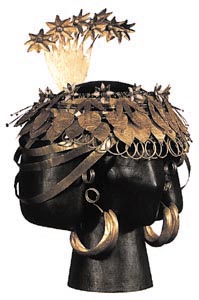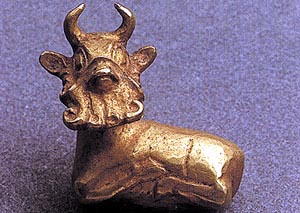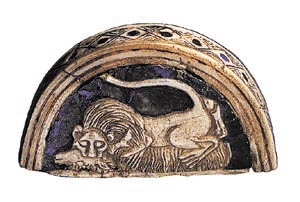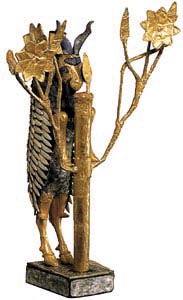‘Treasures from the Royal Tombs of Ur’ opens Saturday
By William HarmsNews Office
One of the world’s greatest archaeological collections–royal jewelry, musical instruments, tools and other artifacts from 4,500-year-old burials in the Sumerian city-state of Ur–are on display from Oct. 21 through Jan. 21, 2001 in the galleries of the Oriental Institute. The exhibition is sponsored by the Pew Charitable Trusts.
The national tour of the exhibition, “Treasures from the Royal Tombs of Ur,” was organized by the University of Pennsylvania Museum of Archaeology and Anthropology, whose archaeologists unearthed the material.
![[lyre]](lyre-bullhead.jpg) A great lyre, one of the oldest musical instruments known, has a sound box that is ornamented with the head of a bull, which is made of gold and lapis lazuli. |
 Queen Puabi’s elaborate headdress |
“This is a remarkable exhibition, and we are privileged to be able to share it with the Chicago area community,” said Gene Gragg, Director of the Oriental Institute. “The Oriental Institute itself has done a great deal of work in this region, so it is appropriate that this material be on display here.”
The Sumerians were creators of one of the world’s earliest civilizations, one that flourished in Mesopotamia, located between the Tigris and Euphrates rivers in what is now Iraq. Their culture emerged in 7000B.C. and by about 3000 B.C., a system of city-states emerged to control the area. They were among the first people to invent writing, using cuneiform script on clay tablets.
As the region was poor in natural resources, the Sumerians established an extensive trading system to supply wood, stone and other raw materials. That trading system reached Egypt, Turkey, Iran, the Persian Gulf, Central Asia and India. Precious and semi-precious stones as well as gold also were imported from distant places, and those materials were fashioned into the goods found in the tombs.
 Gold bull amulet |
The Sumerian queen was laid to rest wearing an elaborate headdress of gold leaves, gold ribbons, strands of lapis lazuli and carnelian beads, a tall comb of gold, chokers, necklaces, a pair of large crescent-shaped earrings, and a cape composed of strings of semi-precious stones.
An ornate diadem made of thousands of small lapis lazuli beads with gold pendants of animals and plants also was found near her head. Nearby was a collection of cosmetic containers, including one with an elaborate shell lid decorated with silver and lapis lazuli. Those objects as well as the headdresses are among items in the exhibition.
 Calcite jar |
Puabi’s tomb was among 1,800 burials excavated at Ur, a city identified in the Bible as the birthplace of Abraham. The excavations were carried out by a joint expedition of the British Museum and the University of Pennsylvania Museum and led by famed British archaeologist C. Leonard Woolley. Woolley considered 16 of the burials to be “royal” because they contained such a wealth of precious materials as well as the bodies of attendants accompanying the main burial.
 A vessel in the form of an ostrich egg; gold, lapis lazuli, red limestone, shell and bitumen. |
“The discovery of Puabi’s tomb created much the same high interest among the public as did the discovery of Tutankhamen’s tomb,” said Karen Wilson, Director of the Oriental Institute Museum. “Looking today at these artifacts reminds us again how accomplished this culture was and why finding this material inspired such attention.”
The statuette called “Ram Caught in a Thicket” caught attention at the time of its discovery because Woolley associated it with the ram caught in a thicket in the biblical story of Abraham and the intended sacrifice of Isaac.
 Copper alloy ax |
Other artifacts in the collection include vessels of gold, silver and calcite, which is a pale translucent stone. Among the items are gold bowls and fluted tumblers made of electrum, which is an alloy of gold and silver.
Also appearing in the exhibition are tools and weapons made from gold, silver, electrum, copper and copper alloys. The items include spears and daggers as well as a razor and tweezers.
 Cosmetic box with lid, inlaid with lapis lazuli, silver and shell |
The Oriental Institute is open from 10 a.m. to 5:30 p.m. Tuesday through Sunday; and from 10 a.m. to 8:30 p.m. Wednesday. The galleries are closed Mondays. Admission to the permanent installation is free, but a donation is suggested for viewing “Treasures from the Royal Tombs of Ur.” An extensive public-education program for adults and children supplements the exhibition.
 “Ram Caught in a Thicket” |
![[Chronicle]](/images/small-header.gif)